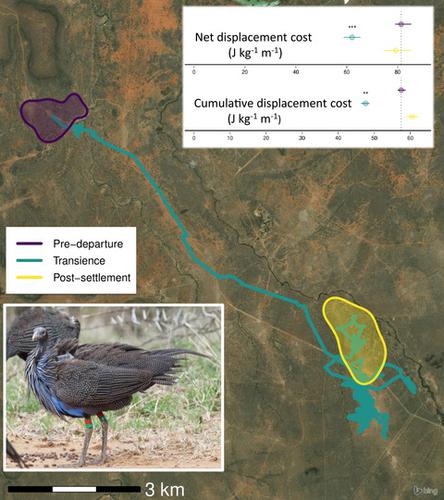当前位置:
X-MOL 学术
›
Ecol. Lett.
›
论文详情
Our official English website, www.x-mol.net, welcomes your
feedback! (Note: you will need to create a separate account there.)
Efficient movement strategies mitigate the energetic cost of dispersal
Ecology Letters ( IF 7.6 ) Pub Date : 2021-05-11 , DOI: 10.1111/ele.13763 James A. Klarevas‐Irby 1, 2, 3, 4, 5 , Martin Wikelski 1, 2, 3 , Damien R. Farine 2, 4, 6, 7
Ecology Letters ( IF 7.6 ) Pub Date : 2021-05-11 , DOI: 10.1111/ele.13763 James A. Klarevas‐Irby 1, 2, 3, 4, 5 , Martin Wikelski 1, 2, 3 , Damien R. Farine 2, 4, 6, 7
Affiliation

|
Dispersal is a critical, but costly, stage of life. During the active phase of dispersal—called transience—individuals face many costs, from increased mortality to reduced foraging opportunities. One cost that is often assumed, but rarely explicitly tested, is the energy expended in making large dispersal movements. However, this cost is not only determined by the distance individual’s move, but also how they move. Using high-resolution GPS tracking of dispersing and resident vulturine guineafowl (Acryllium vulturinum), we show that transient individuals exhibit distinct movement behaviours—travelling farther, faster and straighter—that result in a significant reduction in the energetic costs of making large displacements. This strategy allows dispersing birds to travel, on average, 33.8% farther each day with only a 4.1% cost increase and without spending more time moving. Our study suggests that adaptive movement strategies can largely mitigate movement costs during dispersal, and that such strategies may be common.
中文翻译:

有效的运动策略减轻分散的能量成本
分散是生命中一个关键但代价高昂的阶段。在传播的活跃阶段(称为短暂),个体面临许多成本,从死亡率增加到觅食机会减少。通常假设但很少明确测试的一项成本是进行大规模分散运动所消耗的能量。然而,这个成本不仅取决于个人移动的距离,还取决于他们的移动方式。使用高分辨率 GPS 跟踪分散和常驻的秃鹰珍珠鸡( Acryllium vulturnum),我们表明瞬态个体表现出不同的运动行为——走得更远、更快、更直——这导致大位移的能量成本显着降低。这种策略允许分散的鸟类每天平均飞行 33.8%,而成本仅增加 4.1%,并且无需花费更多时间移动。我们的研究表明,适应性运动策略可以在很大程度上降低分散过程中的运动成本,并且此类策略可能很常见。
更新日期:2021-06-13
中文翻译:

有效的运动策略减轻分散的能量成本
分散是生命中一个关键但代价高昂的阶段。在传播的活跃阶段(称为短暂),个体面临许多成本,从死亡率增加到觅食机会减少。通常假设但很少明确测试的一项成本是进行大规模分散运动所消耗的能量。然而,这个成本不仅取决于个人移动的距离,还取决于他们的移动方式。使用高分辨率 GPS 跟踪分散和常驻的秃鹰珍珠鸡( Acryllium vulturnum),我们表明瞬态个体表现出不同的运动行为——走得更远、更快、更直——这导致大位移的能量成本显着降低。这种策略允许分散的鸟类每天平均飞行 33.8%,而成本仅增加 4.1%,并且无需花费更多时间移动。我们的研究表明,适应性运动策略可以在很大程度上降低分散过程中的运动成本,并且此类策略可能很常见。











































 京公网安备 11010802027423号
京公网安备 11010802027423号